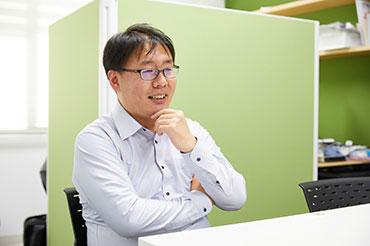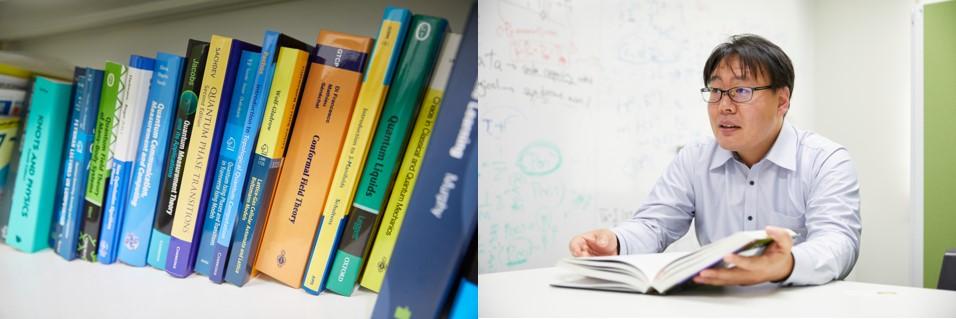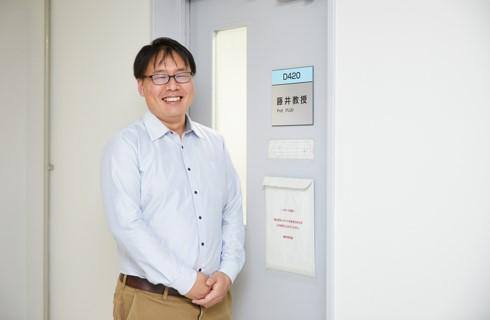Latest Research
Quantum computers --- 10 years of rapid development
PROFESSOR. Keisuke Fujii
 I first learned about
the existence of quantum computers in 2004 when I was in the third year of university. The word quantum
computer itself was not yet known to the world. When I got my PhD in quantum computer theory in 2011, the
name was spreading, but there were still many researchers dealing with a science fiction, so I was in
trouble because I couldn’t find an academic position at that time.
I first learned about
the existence of quantum computers in 2004 when I was in the third year of university. The word quantum
computer itself was not yet known to the world. When I got my PhD in quantum computer theory in 2011, the
name was spreading, but there were still many researchers dealing with a science fiction, so I was in
trouble because I couldn’t find an academic position at that time.
Only 10 years later, quantum technology, including quantum computers, has become one of the three pillars of science and technology that the government emphasizes, along with AI and biotechnology. Even in science and technology, there are many fields that have already matured, but there are few areas that are progressing day by day.
Many researchers were pessimistic about the realization, but it was in 2014, when Google entered the market in earnest, that the world trend changed drastically as “quantum computers could be realized”. However, even then, I never imagined that quantum computers would develop until they could compete with supercomputers in 2019, just five years later.
Large national projects such as the Quantum Leap Flagship Program (Q-LEAP), in which I participate as one of representative researchers, are starting in Japan as well. I hope that in 10 years, a future that can’t be imagined will appear.
NISQ --- Uncertain now is the time to do
 It may still take
more than 20 years to realize a large-scale quantum computer (Error-tolerant quantum computer). Today, the
world is competing with every day for research to connect small and medium-scale quantum computer technology
(NISQ: Noisy Intermediate-Scale Quantum Computer) that will be realized in the near future to some kind of
application. Although NISQ is still small and noisy and not completely free to use, it is becoming a device
that can perform so much that it is difficult to simulate with a supercomputer. We are conducting research
on applications in various fields such as machine learning, condensed matter physics, quantum chemistry, and
financial calculations.
It may still take
more than 20 years to realize a large-scale quantum computer (Error-tolerant quantum computer). Today, the
world is competing with every day for research to connect small and medium-scale quantum computer technology
(NISQ: Noisy Intermediate-Scale Quantum Computer) that will be realized in the near future to some kind of
application. Although NISQ is still small and noisy and not completely free to use, it is becoming a device
that can perform so much that it is difficult to simulate with a supercomputer. We are conducting research
on applications in various fields such as machine learning, condensed matter physics, quantum chemistry, and
financial calculations.
It’s not yet clear if the NISQ machine will create a killer application that goes beyond traditional computers, but it will explode the moment it turns out to be an advantage for NISQ. It will be too late to enter at that point. Now that the superiority of NISQ is uncertain, we must do basic research.
Large-scale quantum computers are very difficult to operate, and hard to reach, but NISQ has become accessible to anyone via the Internet using Amazon Brackets provided by Amazon Web Services and Cloud Systems provided by IBM. It’s been a great time. As an entrance to the quantum computer, it is becoming easier for researchers and companies in other fields who want to use the quantum computer even if they are not interested in itself.
Attractiveness that connects fundamental physics and application
Originally, I wanted to make things, so I chose the faculty of engineering at the university.
On the other hand, I also liked the simple physical law of quantum mechanics. At that time, I came across a quantum computer. “Application of fundamental physical laws for manufacturing”: I was attracted to the concept which is exactly what I was looking for. Since then, I have been continuing my studies under the slogan.
 When I was an
assistant professor at the Hakubi Center of Kyoto University (2013-2016), I came up with a theory that
utilizes quantum computers for machine learning. This was the result of the first discussion with Dr. Kohei
Nakajima (Currently a specially appointed associate professor at the University of Tokyo), who was doing
research to “calculate” using octopus’s legs at the Hakubi center around the same time, from the question of
why it needs to be an octopus.
When I was an
assistant professor at the Hakubi Center of Kyoto University (2013-2016), I came up with a theory that
utilizes quantum computers for machine learning. This was the result of the first discussion with Dr. Kohei
Nakajima (Currently a specially appointed associate professor at the University of Tokyo), who was doing
research to “calculate” using octopus’s legs at the Hakubi center around the same time, from the question of
why it needs to be an octopus.
The calculation system by shaking the artificial “octopus legs” in water to calculate is to let the octopus legs themselves calculate and learn a complicated formula that controls the octopus legs with multiple degrees of freedom. Then, I was able to publish a paper on how to use a quantum computer for machine learning by wondering what would happen if the physical laws of quantum mechanics were used instead of the octopus’s legs.
This was well ahead of the global trend of exploring the application of NISQ to machine learning, which is our strength. Immediately after publishing quantum circuit learning that applies NISQ devices to supervised machine learning, a group of IBM in the United States cited the article and succeeded in experiments. In this way, it is currently attracting attention as the number of citations is in the top 1%.
Osaka University, strong in quantum research
I joined the School of Engineering Science as a professor in 2019. “The School of Engineering Science” is a faculty that shapes the cutting-edge science and technology of the times by fusing basic science and application, so I think it is suitable for research on quantum technology. There are many researchers originally related to quantum computers. Before I studied at the Hakubi Center, I was allowed to study for two years from 2011 as a Research Fellow in the laboratory of Prof. Nobuyuki Imoto, who had been studying quantum information science since the dawn at the School of Engineering Science. There, I was free to research and produce achievements, and then my career gradually opened up.
Osaka University also has a leading interdisciplinary research institute, Center for Quantum Information and Quantum Biology (QIQB), and there are researchers in various fields. Even if students who want to study quantum computers decide to choose a laboratory, it is not the case that each university still has one, but Osaka University is in a privileged environment with many top-class researchers in Japan from theory to experiments and application fields.
However, there is still a shortage of people. Developing human resource at the university takes time. We have also launched a venture company with professionals who mastered quantum computers. We are also promoting collaboration between universities and companies in a wide range of industries. Through collaborative research, companies will be able to develop human resources who will be responsible for quantum computers in-house in the future, and we will be able to obtain research leaders and funds that compete with the world. We aim to lay the foundation for social implementation in a win-win relationship.
